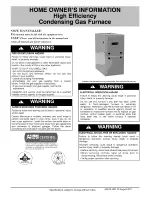
25
NOTE:
If the condition which originally caused the lockout still
exists, the control will return to lockout. Refer to the Diagnostic
Chart for aid in determining the cause.
Maintenance
T
O
AVOID
ELECTRICAL
SHOCK
,
INJURY
OR
DEATH
,
DISCONNECT
ELECTRICAL
POWER
BEFORE
PERFORMING
ANY
MAINTENANCE
. I
F
YOU
MUST
HANDLE
THE
IGNITER
,
HANDLE
WITH
CARE
. T
OUCHING
THE
IGNITER
ELEMENT
WITH
BARE
FINGERS
,
ROUGH
HANDLING
,
OR
VIBRATION
COULD
DAMAGE
THE
IGNITER
RESULTING
IN
PREMATURE
FAILURE
. O
NLY
A
QUALIFIED
SERVICER
SHOULD
EVER
HANDLE
THE
IGNITER
.
WARNING
Annual inspection
The furnace should be inspected by a qualified installer, or
service agency at least once per year. This check should be
performed at the beginning of the heating season. This will
ensure that all furnace components are in proper working or-
der and that the heating system functions appropriately. Pay
particular attention to the following items. Repair or service
as necessary.
•
Flue pipe system. Check for blockage and/or leakage.
Check the outside termination and the connections
at and internal to the furnace.
•
Heat exchanger. Check for corrosion and/or buildup
within the heat exchanger passageways.
•
Burners. Check for proper ignition, burner flame, and
flame sense.
• Wiring. Check that electrical connections are tight
and free from corrosion.
• Filters.
Filters
T
O
AVOID
PROPERTY
DAMAGE
,
PERSONAL
INJURY
OR
DEATH
,
DISCONNECT
ELECTRICAL
POWER
BEFORE
REMOVING
FILTERS
. N
EVER
OPERATE
FURNACE
WITHOUT
A
FILTER
INSTALLED
BECAUSE
DUST
AND
LINT
WILL
BUILD
UP
ON
INTERNAL
PARTS
RESULTING
IN
LOSS
OF
EFFICIENCY
,
EQUIPMENT
DAMAGE
AND
POSSIBLE
FIRE
.
WARNING
A return air filter is not supplied with this furnace; however,
there must be a means of filtering all of the return air. The
installer will supply filter(s) at the time of installation.
Filter Maintenance
Improper filter maintenance is the most common cause of
inadequate heating or cooling performance. Filters should
be cleaned (permanent) or replaced (disposable) every two
months or as required.
Primary Limit
The primary limit control is located on the partition panel and
monitors heat exchanger compartment temperatures. It is an
automatic reset, temperature sensor. The limit guards against
the overheating resulting from insufficient air passing over the
heat exchanger.
Auxiliary Limit
The auxiliary limit control is located either on or near the
circulator blower and monitors heat exchanger compartment
temperatures. The control is an automatic reset, temperature
sensor. It guards against overheating resulting from insuffi
-
cient air passing over the heat exchanger. The auxiliary limit
control is suitable for both horizontal right and horizontal left
installations. Regardless of airflow direction, it does not need
to be relocated.
Rollout Limits
The rollout limit controls are mounted on the burner/manifold
assembly and monitor the burner flame. They are manual-re
-
set, temperature sensors. This limit guards against burner
flames not being properly drawn into the heat exchanger.
Pressure Switches
The pressure switches are normally-open, negative air pres-
sure-activated switches. They monitor the airflow (combustion
air and flue products) through the heat exchanger via pressure
taps located on the induced draft blower. These switches
guard against insufficient airflow (combustion air and flue
products) through the heat exchanger.
Flame Sensor
The flame sensor is a probe mounted to the burner/manifold
assembly which uses the principle of flame rectification to
determine the presence or absence of flame.
Troubleshooting
Diagnostic Chart
Refer to the troubleshooting chart in the Appendix for assis-
tance in determining the source of unit operational problems.
The red diagnostic LED blinks to assist in troubleshooting the
unit. The number of blinks refer to a specific code.
Resetting From Lockout
Furnace lockout results when a furnace is unable to achieve
ignition after three attempts. It is characterized by a non-func-
tioning furnace and a one flash diagnostic LED code from the
red LED. If the furnace is in “lockout”, it will (or can be) reset
in any of the following ways.
1. Automatic reset. The integrated control module will
automatically reset itself and attempt to resume normal
operations following a one hour lockout period.
2. Manual power interruption. Interrupt 115 volt power to
the furnace for 1 - 20 seconds.
3. Manual thermostat cycle. Lower the thermostat so that
there is no longer a call for heat for 1 - 20 seconds then
reset to previous setting.
















































